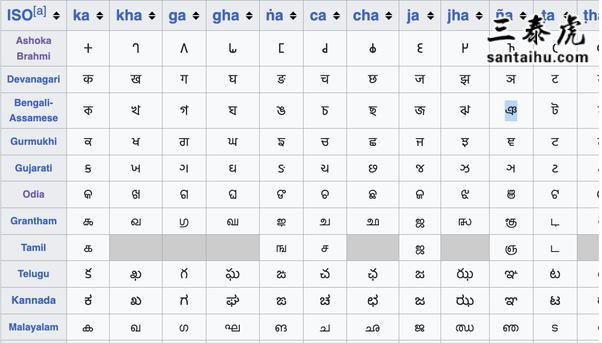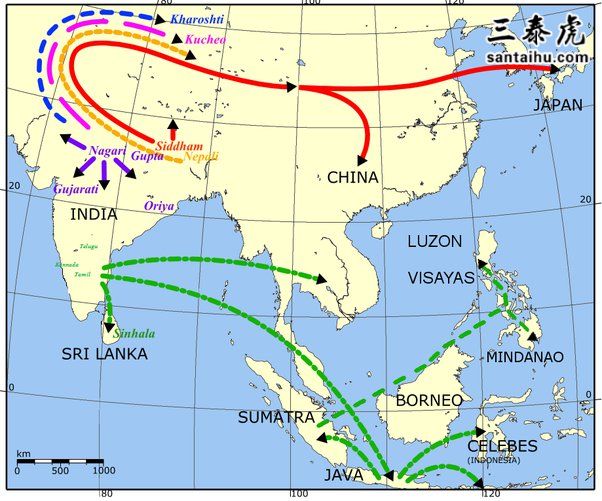Why don't both ancient and modern Indians use a single writing system for all languages as the Chinese have done since the Qin Dynasty? The Indian subcontinent is not really as completely divided geographically as Europe. So what is the reason?
印度有着众多语言,为什么从古至今都没有像中国在秦朝那样统一文字呢?印度次大陆并没有像欧洲那样彻底分裂,为什么?
以下是Quora网友的评论:
Lalit Patel
My knowledge here is limited, but my perspective regarding this can be helpful
At a certain point in history, kings of different regions might have felt that devising their own unique script would allow them to "put curtains on" their information.
The arrival of mughals in India activated this strategy further. Bengal and Punjab region developed their own scripts, different from the earlier Devanagari script.
我对这方面的了解有限,但我的观点可能有点用处。
在历史上的某一时刻,不同地区的国王可能会觉得,本国独特的文字可以阻挡情报消息的泄露。
莫卧儿人的到来进一步强化了这一策略。孟加拉和旁遮普地区创造了自己的文字体系,不同于早期的梵文文字。
Thereafter Britishers developed a different (Gujarati) script for the region of today's Gujarat. Gujarati language textbooks of up to 1850 were in Devnagari script; those of about 1850 to 1940 had poetry in Devnagari script and prose in Gujarati script; and those beyond 1940 are fully in Gujarati script.
India is a nation of order through chaos!
后来英国人为如今的古吉拉特邦地区设计了一种不同的(古吉拉特邦语)文字。1850年以前,古吉拉特地区的教科书都是梵文;大约在1850年到1940年,诗歌会用梵文,散文会用古吉拉特文;但1940年以后就全都改成古吉拉特文了。
印度就是一个在混乱中保持秩序的国家!
Dr. Balaji Viswanathan
Ancient India had a fairly unified script that is 1000s of years old. Nearly all major Indian languages uses scripts derived from this.
You can still see the unifying characteristics. For instance, all major Indian languages use two forms of vowels — a, aa, i, ii, u, uu, etc and all constants have a short vowel — ka, nga, cha etc.
古印度曾有过相对统一的文字,使用了1000多年。印度几乎所有主流语言使用的文字都源于这种文字。
现在依然可以看到相同之处。例如,所有印度主流语言都使用两种形式的元音—a, aa, i, ii, u, uu等,所有常量都有一个短元音- ka, nga, cha等。

Over 1000s of years of evolution, they got fairly different. Unlike ancient Rome or China, India often didn’t have centralized political structures. The nation always used distributed systems with varying groups trying to have a distinct identity within the system.
There are 2 key variants of Brahmi - Northern Brahmic and Southern Brahmic and both of them spread from India to rest of Asia.
经过1000多年的演变,它们已经出现了很多差异。与古罗马或中国不同,印度通常并没有中央的政治结构。国家总是使用分散式的系统,不同的群体在系统中拥有不同的身份。
婆罗门有两个主要的分支—北婆罗门和南婆罗门,它们都从印度传播到亚洲其他地区。

Today, Devanagari is the dominant script that is understood by majority of Indians. However, the strive to protect our complete culture is strong and thus we also support and maintain other scripts.
今天,大多数印度人都能读懂的主要文字是梵文。但我们也努力保护我们完整的文化,因此我们也支持和保护其他文字。
Joseph Taylor
The question of why India doesn't use a single writing system for all languages, akin to China's unified system, is complex and rooted in historical, cultural, linguistic, and political factors. Here are several reasons contributing to the diversity of writing systems in India:
为什么印度不像中国那样用统一的文字来代表所有语言,这是一个复杂的问题,受到了历史、文化、语言和政治等多重因素的影响。以下是导致印度文字系统多样性的几个原因:
1. Linguistic Diversity: India is incredibly diverse linguistically, with over 1,600 languages spoken across the country. This linguistic diversity reflects India's rich cultural heritage and historical evolution. Each language has its own unique script, phonetics, and grammar, reflecting the identity and history of its speakers.
1. 语言多样性:印度的语言多样性之丰富令人咋舌,全有1600多种语言。这种语言多样性反映了印度丰富的文化遗产和历史演变。每种语言都有自己独特的文字、语音学和语法。
2. Historical Development: India's linguistic diversity has deep historical roots, with various languages and scripts evolving over millennia. The Indian subcontinent has been home to numerous civilizations, each contributing to the development of languages and scripts. For example, scripts such as Brahmi, which originated in ancient India, gave rise to several modern scripts, including Devanagari, Tamil, Telugu, Kannada, and others.
2. 历史发展:印度的语言多样性有着深厚的历史根源,各种语言和文字在数千年的时间里不断演变。印度次大陆是众多文明的家园,每种文明都对语言和文字的发展做出过贡献。例如,起源于古印度的梵语等文字就衍生出了几种现代文字,包括梵文、泰米尔文、泰卢固文、卡纳达文等。
3. Cultural Identity: Language and script are integral components of cultural identity for communities in India. Language is not merely a means of communication but also a repository of history, literature, and tradition. The use of distinct scripts reinforces the cultural distinctiveness of different linguistic communities.
3. 文化认同:语言和文字是印度社区文化认同的组成部分。语言不仅是一种交流手段,也是历史、文学和传统的宝库。不同文字的使用加强了不同语言群体的文化独特性。
4. Political Considerations: Language and script have been central to political movements and identity politics in India. Various linguistic communities have advocated for the preservation and promotion of their languages and scripts, often as a means of asserting cultural and political autonomy. Recognizing multiple scripts accommodates the linguistic diversity and aspirations of different communities.
4. 政治考量:在印度,语言和文字一直是政治运动和身份政治的核心。各种语言团体都主张保护和促进他们各自的语言和文字,作为维护文化和政治自治的一种手段。承认多种语言可以适应不同社区的语言多样性和愿望。
5. Constitutional Provisions: The Constitution of India recognizes the linguistic diversity of the country and grants official status to 22 languages, including Hindi, Bengali, Telugu, Marathi, Tamil, Urdu, Gujarati, and others. Each of these languages is entitled to its own script and educational resources, ensuring linguistic rights and cultural diversity.
5. 宪法条文:印度宪法承认印度语言的多样性,并为22种语言授予官方语言的地位,包括印地语、孟加拉语、泰卢固语、马拉地语、泰米尔语、乌尔都语、古吉拉特语等。每一种语言都有权获得自己的文字和教育资源,确保语言权利和文化多样性。
6. Practical Considerations: While a unified script may seem convenient for administrative purposes, imposing a single writing system on diverse linguistic communities could be linguistically and culturally insensitive. Learning and using a script are deeply intertwined with language acquisition and cultural identity. Adopting a single script for all languages could undermine linguistic diversity and cultural heritage.
6. 现实考量:虽然统一的文字更方便管理,但将统一的文字系统强加给不同的语言社区,可能在语言和文化上都不太合适。学习和使用某种文字与语言习得和文化认同密切相关。要求所有语言采用统一文字可能会破坏语言多样性和文化遗产。
In summary, the linguistic diversity and cultural richness of India have led to the proliferation of distinct writing systems, each reflecting the unique identity and history of its respective linguistic community. While a unified script may offer administrative simplicity, it would overlook the intricate tapestry of India's linguistic and cultural landscape. Recognizing and celebrating linguistic diversity remains a cornerstone of India's pluralistic society.
总之,印度语言的多样性和文化的丰富性导致了不同文字系统的激增,每一种语言都反映了各自语言社区的独特身份和历史。虽然统一的文字便于管理,但也会忽略印度复杂的语言和文化景观。承认和颂扬语言多样性仍然是印度多元化社会的基石。
Clifford Nelson
I think I need to educate you since you assume that China uses the same writing system for all languages. It does not. The Mandarin Hanzi are each associated with a sound, and the phrases for the same object are different form different languages
我想我得跟你说道说道了,因为你觉得中国所有语言使用了相同的书写系统,但事实并非如此。普通话的每一个汉字都和一个发音相关联,表示同一对象的措词在不同的语言中也是各不相同的
Mother in Cantonese: 亞媽
Mother in Mandarin: 妈妈
Mother in Tibain: ཨ་མ།
Mother in Ughur: ئانا
It is impossible to have a different spoken language be different while the written language is the same if the written language is based on the sound of the words.
粤语中,母亲是:亞媽
普通话中,母亲是:妈妈
藏语中,母亲是:ཨ་མ།
维吾尔语中,母亲是:ئانا
如果书面语言以单词的发音为基础,那么不同方言不可能拥有相同的书面语言。
Ted Chyn
Before the conquest and colonization of India by the British, the Indian continent consisted of numerous small kingdoms, each with its language, customs, and religious practices. India was more of a cultural and geographical concept rather than a unified political entity. The British colonial rule, which lasted for nearly two centuries, had a profound impact on the Indian subcontinent, sha its political, economic, and social structures.
在英国人征服和殖民印度之前,印度大陆由众多小王国组成,每个小王国都有自己的语言、习俗和宗教习俗。印度这个词更多的是一个文化和地理的概念,并非是一个统一的政治实体。英国对印度进行了近两个世纪的殖民统治,对印度次大陆产生了深远的影响,塑造了印度的政治、经济和社会结构。
After gaining independence from British rule in 1947, India was partitioned into two separate nations: India and Pakistan. This division was based largely on religious lines, with Pakistan being established as a separate state for Muslims. India itself became a federal republic, with a de ocratic system of government that granted considerable autonomy to its states.
1947年,印度从英国殖民统治下获得独立后,印度被分割成两个独立的国家:印度和巴基斯坦。这种划分主要是基于宗教界限,巴基斯坦成了一个MSL国家。印度自己则成了一个联邦共和国,拥有皿煮的政府制度,赋予了各邦相当大的自治权。
Even today, India remains a diverse and complex federation with a federal system of government. The country is made up of 28 states and 8 union territories, each with its own distinct cultural, linguistic, and historical identity. The states have significant authority over various aspects of governance, including commerce, education, and law enforcement. This decentralized structure often leads to variations in economic development, governance effectiveness, and social progress across different regions of the country. The legacy of colonialism, along with the vast diversity of India's population and its federal structure, indeed contributes to the complexties and challenges of governance and development in the country.
时至今日,印度仍然是一个采用联邦制政府的多元复杂的联邦国家。这个国家由28个邦和8个联邦领地组成,每个邦都有各自独特的文化、语言和历史身份。各邦在包括商业、教育和执法在内的治理各个方面都拥有重大的权力。这种分权结构往往导致该国不同地区的经济发展、治理效率和社会发展方面存在着差异。殖民*义的历史遗留问题,加上印度人口的多样性及其联邦结构,确实加大了印度治理和发展的复杂性和挑战性。
Bill Zhang
It took a great king to do such revolutionary work and luckily China got many while others didn’t or don’t have.
这需要一个伟大的国王才能推动这样的革命,幸运的是,中国历史上出现过很多伟大的皇帝,但其他国家就没有这么幸运了。
Mohan Kalaiselvan
Each language has prefered a script that represents their sound system the best. Having just one nation one script brings no benefit.
每种语言都更喜欢最能代表自己语言发音的文字。一个国家只有一种文字,也并没有什么好处。
Mahi
Your question pertains to the writing systems of North and South India. It’s important to note that North India is predominantly home to Indo-Aryan languages, while South India is largely populated by speakers of Dravidian languages. These two language families are fundamentally different from each other.
你的问题涉及印度北部和南部的书写体系。值得注意的是,北印度主要是印度雅利安语的发源地,而南印度主要是说德拉威语的人。这两个语系存在着本质的区别。
Take, for example, the South Indian languages. Tamil, which has the most Dravidian traits among them, is significantly different from other South Indian languages. This is evident even in everyday phrases and greetings.
Therefore, it’s not feasible to use a single script to write all South Indian languages. The Tamil script, for instance, cannot represent many of the sounds found in Kannada and Malayalam.
以南印度语为例。泰米尔语是最具德拉威人特征的语言,与其他南印度语言存在着很大的不同。这一点在日常用语和问候中也很明显。
因此,用一种单一的文字体系来代表所有的南印度语言是行不通的。例如,泰米尔语的文字就无法代表卡纳达语和马拉雅拉姆语中的许多发音。
In North India, most languages are phonetic and have similar syllables. They can be easily accommodated by the Devanagari script, as they mostly originate from the Sanskrit/Prakrit family. While many of these languages have adopted the Nagari script over time, some, like Bengali and Odia, continue to use their unique scripts. This could be due to similar challenges faced by the South Indian languages, or simply a reluctance to give up their traditional scripts.
在印度北部,大多数语言发音相似,有着相似的音节。梵文就可以轻松涵盖这些语言,因为它们大多来自梵文/古代印度语家族。虽然随着时间的推移,这些语言中有许多都采用了那格利文字,但也有一些语言,如孟加拉语和奥里亚语,则继续使用它们独特的文字。这可能是由于南印度语言也同样面临的挑战,或者单纯只是不愿放弃他们的传统文字。
In terms of communication, Hindi serves as a link language in North India, while English plays a similar role in South India. Thus, instead of homogenizing all languages, these regions have opted to use link languages for better understanding and communication.
在交流方面,北印度以印地语为交流语言,南印度以英语为交流语言。因此,这些地区没有将所有语言同化,而是选择使用桥梁语言来促进理解和沟通。
Bhavana Arun
India is known for its languages. Each language has its own writing style which for many years has been followed and I agree it should be. All languages have their beauty because of different writing and sound style. Each word in any language has a unique sound and writing.
印度以语言繁多而闻名。每一种语言都有自己的文字,多年来人们一直延用各自的文字,我认为印度人应该这么做。所有的语言都因不同的文字和发音而各有其美。每种语言的每个单词都有独特的发音和书写方式。
此文由 三泰虎 编辑,未经允许不得转载!:首页 > 印度看中国 » 印度有着众多语言,为什么从古至今都没有像中国在秦朝那样统一文字呢